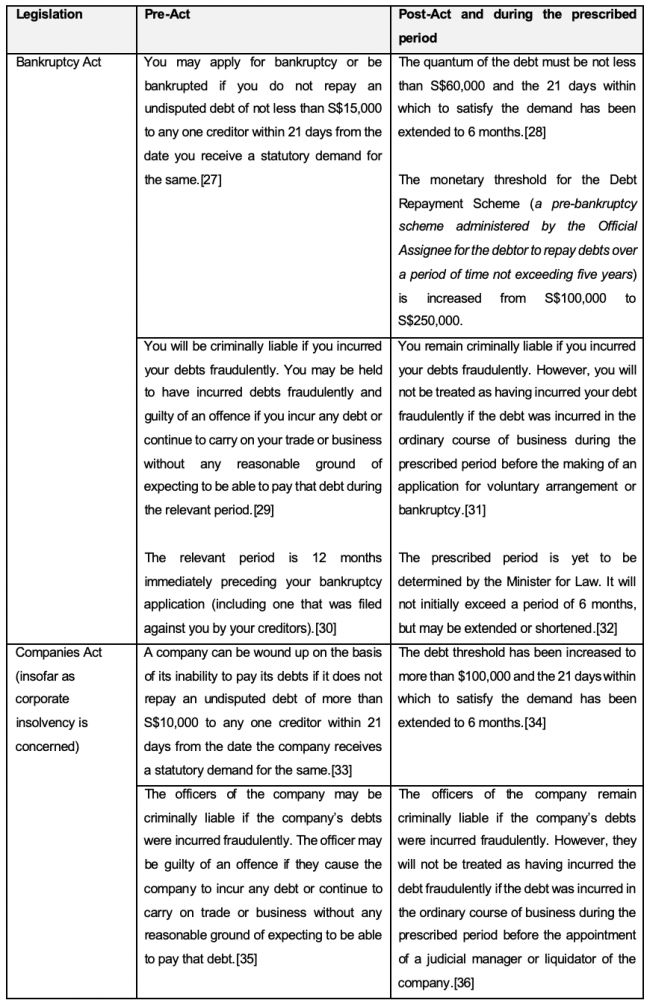Post-script: "On 20 April 2020, the Minister for Law notified the commencement of Parts 2 and 3 of the Act with effect from 20 April 20201and that the prescribed period for the purposes of Parts 2 and 3 is 6 months commencing on 20 April 2020 and ending on 19 October 2020 in the first instance. 2he regulations referred to in our article below as at the date of this update can be accessed here, and the application portal for an assessor's determination can be accessed here."
On 7 April 2020, the Singapore government passed a wide-ranging bill known as the COVID-19 (Temporary Measures) Act 2020 (the "Act"). Among other things, the Act provides temporary relief to private contracting parties who find themselves unable to fulfil their contractual obligations due to the disruption caused by the ongoing pandemic.
This article provides you with a brief overview of the key temporary relief measures prescribed by the Act that are most relevant to businesses and business-owners. In outline, the temporary measures we focus on in this article are initially intended to last for a maximum of six months (the "prescribed period") upon the commencement of the parts of the Act containing these measures and may be extended for up to 12 months. We discuss the provisions regarding the timing of the measures in more detail below.
What are the temporary relief measures introduced by the Act?
The Act is divided into several parts. Part 2 effectively introduces a statutory moratorium preventing the commencement of legal and enforcement action against those whose inability to perform certain defined contractual obligations are due to a material extent to COVID-19. Part 3 temporarily modifies the laws of bankruptcy and corporate insolvency to be more forgiving to entrepreneurs and business-owners. Parts 4 and 5 provide for the alternative modes through which company meetings and court proceedings can be held. Part 6 requires property owners to pass the benefits of any property tax rebates they have been provided with during this period to their tenants. Finally, Part 7 relates to the control orders and enforcement action that can be taken to prevent the spread of COVID-19. As this article is aimed at providing further information to help businesses and business-owners cope with legal and financial stresses caused by the pandemic, our attention will be focused on Parts 2 and 3 of the Act, which will come into operation on a date that the Minister for Law appoints by notification in the Government Gazette. Our colleagues have published separate commentaries on Part 4 and Part 7.
The statutory moratorium (Part 2)
Parties to contracts entered into or renewed before 25 March 2020 and listed in the schedule to the Act who find themselves unable to fulfil their contractual obligations from 1 February 2020 due to a material extent by COVID-19 can avail themselves of the statutory moratorium prescribed in section 5 of the Act.3The relief from contractual obligations will only apply if the inability to perform is materially caused by a COVID-19 event, so it will be important that businesses maintain or keep proper documentation to show this.
What contracts do these measures apply to?
The contracts listed in the schedule to the Act are as follows:
- Event contracts;
- Tourism-related contracts;
- Construction contracts or supply contracts;
- Lease or licences of non-residential immovable property;
- Performance bonds granted pursuant to construction contracts or supply contracts;
- Certain hire-purchase agreements or conditional sales agreements relating to commercial vehicles or plant, machinery, or fixed assets in Singapore which are used for manufacturing, production, or other business purposes;
- Certain secured loan facilities provided by licensed banks and finance companies to qualifying small and medium enterprises (being businesses in Singapore where not less than 30 per cent of its shares or other ownership interest are held by citizens and/or permanent residents of Singapore and the turnover of the group to which it belongs is not more than $100 million in the latest financial year); and
- Loans from licensed banks and finance companies that are secured against commercial or industrial immovable property located in Singapore, or secured against plant, machinery, or fixed assets that are used for manufacturing, production, or other business purposes.
There is additional relief for specific contracts. For construction or supply contracts, once a valid notification for relief has been served, liquidated damages cannot be imposed for delays and breaches that occur during the period that the moratorium is in place, if the delay or breach is attributable to a COVID-19 event.4
For event or tourism related contracts, once a valid notification for relief has been served, any non-refundable deposit that has been forfeited must be refunded, including those that were forfeited from 1 February 2020. 5e sole exception is if an assessor determines otherwise (see below). 6urther, note that cancellation fees cannot be imposed if the inability to perform the contract was materially caused by a COVID-19 event.7>
What is the effect of the statutory moratorium?
The section 5 moratorium prevents the commencement or continuation of any court or domestic arbitration action against the affected party or their guarantor; 7rt and insolvency proceedings (including applications for bankruptcy, winding up, judicial management and schemes of arrangement) and enforcement of judgments and domestic arbitrations against the affected party or their guarantor;9 the commencement or levying of execution, distress or other legal process against the affected party or their guarantor unless leave of court has been obtained;10 the appointment of a receiver or manager against the affected party or their guarantor;11 the enforcement of any security that has been granted over movable or immovable property used for the purpose of a trade, business, or profession;12 and the repossession of goods that are necessary for business operations despite the terms of any lease, hire-purchase agreement, or retention of title clause.13 The moratorium also prevents the exercise of rights of re-entry or forfeiture of a lease or licence of immovable property and the termination of a lease or licence of immovable property due to non-payment of money (whether for rent or otherwise).14
Note, however, that force majeure clauses and the Frustrated Contracts Act will prevail over the Act.15 If your contracts contain a force majeure clause, consider obtaining legal advice as to whether your force majeure clause has been worded appropriately so as to cover the impact of COVID-19 on your ability to perform as an alternative to relying upon the temporary reliefs under the Act16 Consider also whether given your circumstances you can assert that your contract has become frustrated.
How can I avail myself of the moratorium?
You must serve a notification for relief on your counterparty, guarantor, and surety in order to have the benefit of this moratorium.17 The notification must contain the prescribed information and must be sent within the time to be specified by the relevant regulations.18 A notification for relief may be issued even before a demand for performance is made by the counterparty. Therefore, you should be prepared to act expeditiously. Once the notification has been served in accordance with the Act, the section 5 moratorium will have effect for a prescribed period not exceeding six months initially.19 Any prohibited action that has already commenced will also be stayed.20 As of the date and time of this article this prescribed period has yet to be determined by the Minister for Law.21
What happens if the moratorium is breached?
Any person who without reasonable excuse breaches this moratorium can be found guilty of an offence and liable on conviction to a fine not exceeding S$1,000.22 If legal action has been commenced against you in breach of this moratorium, you should immediately lodge a copy of the notification for relief with the court, arbitral tribunal, or person or body before whom proceedings have been brought against you. Upon your lodgement of the notification for relief, that action will be dismissed as the Act mandates that the court, arbitral tribunal, or person or body do so without exception.23 Note that rights may be lost if parties ignore the Act and decide to serve proceedings since if a matter is dismissed by a court or tribunal it may not be possible to revive the cause of action.
My counterparty has filed a notification for relief but their failure to perform their contractual obligation is not due to COVID-19. What can I do?
If you are the party to whom an obligation is owed under a contract and you are of the view that your counterparty's position that it is unable to perform their contractual obligations due to COVID-19 is not genuine, you have recourse. You can apply to the Registrar of assessors for an assessment of whether the Act applies in your circumstances so as to prohibit you from enforcing your rights against your counterparty.24 The Registrar of assessors and a panel of assessors will be appointed by the Minister for Law. Assessors will have the power to grant relief to achieve a "just and equitable" outcome. There will be no appeals following a determination by an assessor.
The assessment process is designed to be expedited and cost-effective, and as such both you and your counterparty must attend the assessment proceedings (which are likely to be held by video or teleconferencing or other similar methods) yourself (and in the case of a company, by an authorised representative) and cannot be represented by lawyers. You may wish to obtain advice to help guide you on the merits of your case for the assessment. While lawyers cannot represent parties before assessors, it is still possible for lawyers to assist parties in gathering evidence and preparing submissions. However, the costs will not be recoverable from the other side even if you succeed.
What else should I take note of in relation to the moratorium?
The Act does not expressly provide that an assessor's decision is to be kept confidential. This may present problems for parties that have arbitration clauses in their contracts, which would otherwise be effective to keep a dispute arising out of the contract out of the public domain.
It must also be noted that whilst Part 2 of the Act prohibits the commencement or continuation of legal or enforcement action temporarily, it does not provide for the suspension of any other right. Note, for example that banks' contractual rights to interest for non-payment or late payment of loan obligations will continue to accrue on your contracts where applicable and the repayment terms and securities that you have provided may be enforced once the temporary relief measures above have expired, unless other laws or regulations apply to limit the effect or enforceability of these terms.
Once Part 2 has commenced, limitation periods will also be extended to cover the period from when a notice of relief is served until the notice ceases to be of effect (whether due to the expiry of Part 2, the notice being withdrawn, or an assessor determining that the defaulting party is not entitled to relief in the circumstances).25
The temporary modifications to the bankruptcy and insolvency regime (Part 3)
Part 3 of the Act temporarily modifies the Bankruptcy Act, the provisions of the Companies Act in relation to corporate insolvency, and the relevant provisions of the passed-but-yet-to-commence Insolvency, Restructuring and Dissolution Act 2018 (also commonly referred to as the "Omnibus Insolvency Act") which consolidates and modernises Singapore's insolvency and debt restructuring regime, so as to be more forgiving to business-owners and entrepreneurs for the duration of the prescribed period.26 The pre- and post-Act exposure of business-owners and businesses to bankruptcy and insolvency can generally be summarised as follows:

What do these temporary modifications mean for creditors and debtors?
These modifications will, during the prescribed period, impact a creditor's entitlement to file or continue and a debtor's exposure to a bankruptcy or winding-up application differently depending on when the statutory demand was served or the application first made.37
For creditors, the effect of these temporary modifications is that once Part 3 has commenced, for the duration of the prescribed period, you will not be entitled to file for the bankruptcy or winding-up of your debtors unless the debt meets or exceeds the heightened monetary thresholds (S$60,000 in the case of individuals, and S$100,000 in the case of companies), and the lengthened period within which that debtor can satisfy or compound your statutory demand (6 months in the case of individuals and companies) has expired. If you have already issued a statutory demand to an individual or corporate debtor before the commencement of Part 3, you may be able to proceed to file a bankruptcy or winding-up application against them during the prescribed period on the basis of that demand.38
A statutory demand is technically not a court proceeding and creditors should still be permitted to issue statutory demands during the prescribed period. However, there will be practical issues in relation to effecting personal service of the statutory demand in the current situation, and it bears highlighting that the 6-month period within which the debtor can satisfy or compound the demand will only start to run from the date personal service is effected and not merely attempted. Further, where the debt relates to a scheduled contract to which Part 2 applies (see above), the debtor may avail itself of the moratorium in which case the issuer will also be prohibited from filing a bankruptcy or winding-up application against the debtor for the duration of the moratorium.39
The title of the Act itself makes it clear that these relief measures are temporary. However, my business was negatively impacted by COVID-19 before the Act commenced (namely, before 7 April 2020). Are the temporary relief measures in Parts 2 and 3 still available to me?
The temporary relief measures contained in Parts 2 and 3 of the Act will only be available to you upon their commencement. These parts have yet to commence as the Minister for Law has yet to order the same as required by the Act.40 Further, Parts 2 and 3 refer to a prescribed period that is to be ordered by the Minister and published in the Government Gazette.41 As of writing the Minister has yet to order the prescribed period. This notwithstanding, it is pertinent to note that the Minister may prescribe a period not exceeding 6 months initially and may lengthen or shorten the prescribed period more than once.42
Once the Minister has ordered the commencement of Part 2, if your contract is a scheduled contract that was entered into or renewed before 25 March 2020, you will be eligible for the reliefs thereunder so long as you fulfil the other conditions prescribed in that part and your inability relates to a contractual obligation from 1 February 2020 onwards.43 In relation to Part 3, much depends on the period prescribed by the Minister. This is because apart from the fact that Part 3 has yet to commence, the modifications to the Bankruptcy Act, Companies Act, and Omnibus Insolvency Act will only apply during the prescribed period, which must also be ordered by the Minister.
How long do each of these relief measures last and when will they expire?
Once Part 2 has commenced and you have served a notification for relief, you will be able to benefit from the moratorium until the earliest of:44
- The expiry of the prescribed period;
- Your withdrawal of your notification for relief; or
- An assessor's determination that the temporary relief measures do not apply to you in the circumstances.
Once Part 3 has commenced, the monetary thresholds and deadlines under the relevant provisions of the Bankruptcy Act, Companies Act, and Omnibus Insolvency Act are modified upwards as tabulated above for the duration of the period to be prescribed by the Minister for Law.
Disclaimer: This update is provided to you for general information and should not be relied upon as legal advice.
Footnotes
1 COVID -19 (Temporary Measures) Act 2020 (Act 14 of 2020) COVID -19 (Temporary Measures) Act 2020
(Commencement) (No. 2) Notification 2020, published in the Government Gazette on 20 April 2020. See http://www.egazette.com.sg/pdf.aspx?ct=sls&yr=2020&filename=20sls300.pdf.
2 COVID-19 (Temporary Measures) Act 2020 (Act 14 of 2020) COVID-19 (Temporary Measures)
(Prescribed Period) Order 2020, published in the Government Gazette on 20 April 2020. See http://www.egazette.com.sg/pdf.aspx?ct=sls&yr=2020&filename=20sls302.pdf.
3 Section 5(2) read with section 5(3). If your contract was automatically renewed on or after 25 March 2020, you will still be able to avail yourself of the statutory moratorium, assuming you have served a notification for relief.
4 Section 6(5).
5 Sections 7(2) and (3).
6 Section 7(2).
7 Section 7(4).
8 Sections 5(3)(a) and (b).
9 Sections 5(3)(e), (f) (g), and (h).
10 Section 5(3)(j).
11 Section 5(3)(i)
12 Sections 5(3)(c) and (d).
13 Section 5(3)(k).
14 Section 5(3)(l) and (m).
15 Section 5(13).
16 Our colleagues have written an article on this issue. See https://www.cnplaw.com/contractual-terms-does-the-novel-coronavirus-covid-19-outbreak-constitute-a-force-majeure-event-in-singapore-cnpupdate-mar2020.
17 Section 5(1)(c).
18 Section 9.
19 Section 5(2)(a) read with section 3(1). The exception is if the notification is withdrawn or if an assessor determines that the case is one to which section 5 does not apply. See section 5(2)(b) and (c).
20 Section 5(8).
21 Section 3(1) and (2).
22 Section 8(1).
23 Section 8(2).
24 Sections 10 to 17.
25 Section 5(7).
26 Part 3 also modifies the relevant provisions of legislation relating to other business organizations such as the Limited Liability Partnerships Act and the Business Trusts Act. For the purposes of this article, however, we focus on the Companies Act.
27 Sections 61(1)(a) and 62(a)(ii) of the Bankruptcy Act.
28 Sections 20(1)(d) and 20(1)(e) read with sections 61(1)(a) and 62(a)(ii) of the Bankruptcy Act.
29 Section 144 of the Bankruptcy Act.
30 Section 144 of the Bankruptcy Act.
31 Section 20(2) read with section 144 of the Bankruptcy Act.
32 Section 3(1).
33 Section 254(2)(a) of the Companies Act.
34 Section 22(1) read with section 254(2)(a) of the Companies Act.
35 Section 339(3) of the Companies Act read with section 340.
36 Section 22(2) read with section 339(3) of the Companies Act.
37 See the savings and transitional provisions contained in section 26.
38 See section 26.
39 Note, however, that it appears that the modified timelines prescribed by Part 3 of the Act will apply.
40 Section 1.
41 Section 3.
42 Section 3.
43 Section 5(2).
44 Section 5(2).
This update is provided to you for general information and should not be relied upon as legal advice.



